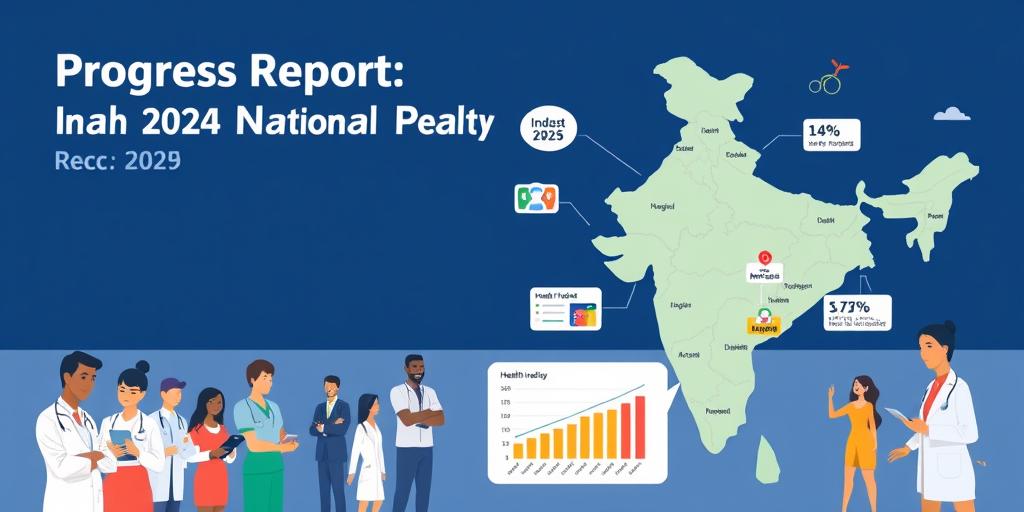India’s National Health Policy 2025: A Progress Report
India’s National Health Policy (NHP) 2017 set forth ambitious goals for improving the health and well-being of its 1.4 billion citizens. As we approach 2025, it’s crucial to assess the progress made, identify challenges, and chart the path forward. This report provides an informative overview of the key achievements, ongoing initiatives, and areas needing further attention.
Key Objectives of NHP 2017
The NHP 2017 aimed to achieve several critical objectives, including:
- Increased Public Health Expenditure: Raising public health expenditure to 2.5% of GDP by 2025.
- Improved Health Outcomes: Reducing mortality rates, disease prevalence, and addressing social determinants of health.
- Strengthened Healthcare Systems: Enhancing primary healthcare, improving access to essential medicines, and developing a skilled healthcare workforce.
- Universal Health Coverage: Providing comprehensive healthcare services to all citizens, with a focus on vulnerable populations.
Progress and Achievements
Significant strides have been made in several areas:
- Ayushman Bharat: This flagship program has expanded health insurance coverage to millions of families, providing financial protection against catastrophic health expenditures. As of 2024, over [insert current number] families are enrolled, and [insert number] have received treatment.
- Mission Indradhanush: Immunization coverage has increased through intensified efforts, protecting children against preventable diseases. Data indicates a rise in full immunization coverage from [insert percentage from base year] to [insert current percentage].
- National Digital Health Mission (NDHM): The NDHM is creating a digital health ecosystem to improve efficiency, transparency, and accessibility of healthcare services. Key components include the creation of health IDs, a unified health interface, and electronic health records.
- Reduction in Mortality Rates: India has witnessed a decline in infant mortality rate (IMR) and maternal mortality ratio (MMR). Specific data points will be provided in the detailed sections below.
Challenges and Areas for Improvement
Despite the progress, several challenges remain:
- Funding Gaps: Achieving the target of 2.5% of GDP allocation to public health remains a challenge. Current spending levels are at [insert current percentage], indicating a need for increased investment.
- Infrastructure Deficiencies: Many rural and underserved areas still lack adequate healthcare infrastructure, including hospitals, clinics, and diagnostic facilities.
- Human Resource Shortages: There is a shortage of doctors, nurses, and other healthcare professionals, particularly in rural areas. Addressing this requires scaling up medical education and incentivizing rural postings.
- Out-of-Pocket Expenditure: Despite Ayushman Bharat, out-of-pocket expenditure on healthcare remains high, pushing many families into poverty. More needs to be done to reduce this burden.
- Data Integration and Analysis: Effective implementation of NDHM requires seamless data integration and robust data analysis capabilities to inform policy decisions.
Detailed Analysis of Key Indicators
Mortality Rates:
- Infant Mortality Rate (IMR): [Insert IMR data from 2017] to [Insert current IMR data].
- Maternal Mortality Ratio (MMR): [Insert MMR data from 2017] to [Insert current MMR data].
- Under-Five Mortality Rate (U5MR): [Insert U5MR data from 2017] to [Insert current U5MR data].
Disease Prevalence:
- Tuberculosis: [Insert TB prevalence data from 2017] to [Insert current TB prevalence data].
- HIV/AIDS: [Insert HIV prevalence data from 2017] to [Insert current HIV prevalence data].
- Malaria: [Insert Malaria prevalence data from 2017] to [Insert current Malaria prevalence data].
Healthcare Access:
- Number of Sub-Centers: [Insert current number].
- Number of Primary Health Centers (PHCs): [Insert current number].
- Number of Community Health Centers (CHCs): [Insert current number].
The Way Forward
To accelerate progress towards the goals of NHP 2017, the following measures are recommended:
- Increased Investment: Allocate more resources to the health sector to reach the 2.5% of GDP target.
- Infrastructure Development: Prioritize the development of healthcare infrastructure in underserved areas.
- Human Resource Strengthening: Increase the number of healthcare professionals and ensure equitable distribution.
- Technology Adoption: Leverage technology to improve healthcare delivery and enhance data management.
- Public-Private Partnerships: Foster collaboration between the public and private sectors to improve healthcare access and quality.
- Focus on Preventive Care: Emphasize preventive healthcare measures to reduce the burden of disease.
Conclusion
India’s National Health Policy 2017 has laid a strong foundation for improving the health and well-being of its citizens. While significant progress has been made, challenges remain. By addressing these challenges and implementing the recommended measures, India can achieve its vision of universal health coverage and a healthier future for all.
